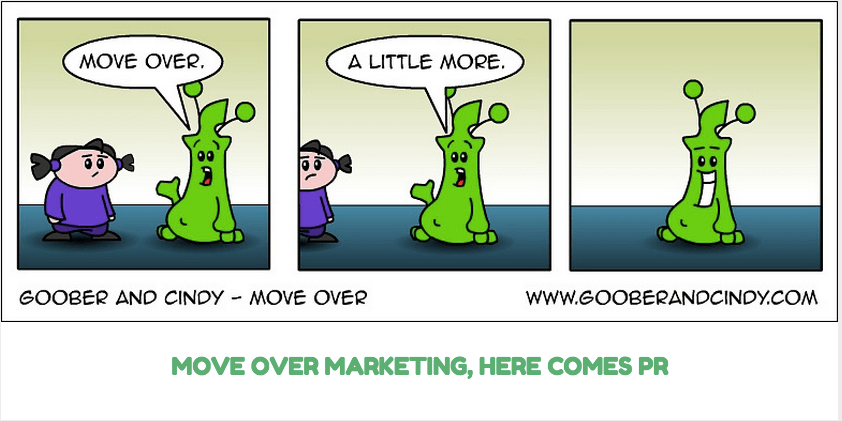During the past five years, there are several big signs that tell us PR has broken out of its silo and we can say, “Move over marketing, here comes PR.”
We have a lot to offer to 21st century business far beyond what was traditionally considered a part of our practice when I entered the workforce 25 years ago.
Have you seen these signs?
The Changing PR Agency Business Model
What was once the agency model broken down by practice areas is changing.
Many agencies are adopting digital or social media structures and being more channel agnostic, understanding the nature of today’s purchaser, and how a mix of media (including paid media) is very important to reach and engage people.
Agencies are offering their clients the best way to engage with their consumers through paid, earned, shared and owned Media (the PESO model), as Gini Dietrich describes in her book, Spin Sucks.
However, because not every agency is equipped to provide these integrated digital and social media services in-house, they’re quickly finding partners who can work with them to offer the best media choices for their clients.
In order for PR agencies to meet the needs of the 21st century, facing technological advances and a changing media landscapes, they must adapt new structures, and change and grow as well.
International Awards for Creative Campaigns
Cheers could be heard across many PR circles when Edelman became the first PR agency to win a Grand Prix at the Cannes Lions International Festival of Creativity for its work on the Chipotle Mexican Grill “The Scarecrow” campaign.
Edelman worked with Creative Artists Agency Los Angeles on a campaign that was linked to the Chipotle “Food with Integrity” initiative, highlighting the chain restaurant’s commitment to sustainably raised food.
But, this is only one example of many.
PR has definitely raised the bar on creative work.
We’re seeing how PR agencies are hiring creative directors, a position that didn’t exist in PR firms when I started out in the late 80s.
Creative directors are using good, insight-driven creative campaigns.
They’re helping to bring together the necessary elements within their agencies to deliver the best creative stories for their clients.
New Professional Skills and Competencies Required
Coming out of college and graduate school years ago, and entering into the field of public relations required great writing, speaking and relationship building skills.
Those skills are still tremendously important.
However, today’s professionals need to be immersed in all different kinds of media to apply their great writing and relationship building practices.
They also have to be critical thinkers and negotiators who are flexible and can adapt to changing global environments.
Today’s professionals must serve the needs of the global business; where communication transcends different borders and boundaries.
At the same time, professionals must have cultural values and sensitivities, and understand the diversity of their teams, as they collaborate with more areas and different people within their organizations.
Strategic Communications Offered in MBA Programs
When I was studying for my MBA in marketing in the late 1990s, there were pages in my marketing textbook that covered issues management, reputation, and ethical communication.
There was no course dedicated to educating executives on the importance of transparent communication, ethical behavior, and reputation and crisis management.
Today, the Public Relations Society of America (PRSA) has partnered with a number of universities to offer a strategic communication course, which covers a number of important topics: corporate communications, integrated marketing communications, investor relations, corporate social responsibility (CSR), government relations, and crisis communications.
Silos Within Organizations are Breaking Down
Communicators are working together; PR, marketing, digital and branding professionals come to the strategy table to collaborate on a program.
PR is no longer just earned media or simply brought in post crisis.
Whether you’re in PR or marketing, you’re in the business of content. Today, content is the best way to engage with people in their communities and to build relationships.
With consumers driving their own communication, deciding who, what, when and where they want to share, PR has to be hands on with digital and social media to reach and engage with audiences, where they choose to congregate.
Whether you’re a B2B, B2C, or non-profit organization, the customer doesn’t care how you create good information, they just demand it from you, and usually want it instantaneously.
The customer doesn’t think about “who does what” to get them what they need. They just want the best experience, proving that all areas of marketing (and customer service too) need to work together.
PR is Expanding
Whether these five signals are a push for PR to “flex” its communication muscles and to say, “Move over marketing, here comes PR,” or perhaps to be more subtle with a, “Hey, marketing, make room for us PR pros,” the outcome is the same.
Public relations is expanding and professionals are experiencing new practices on the job.
Working more closely with marketing and various types of media, showing greater flexibility and adaptability in the global organization and being more digital and social savvy is a great way to demonstrate value in your organization, raising the bar with new PR practices
image credit: Goober and Cindy and a little Canva magic
